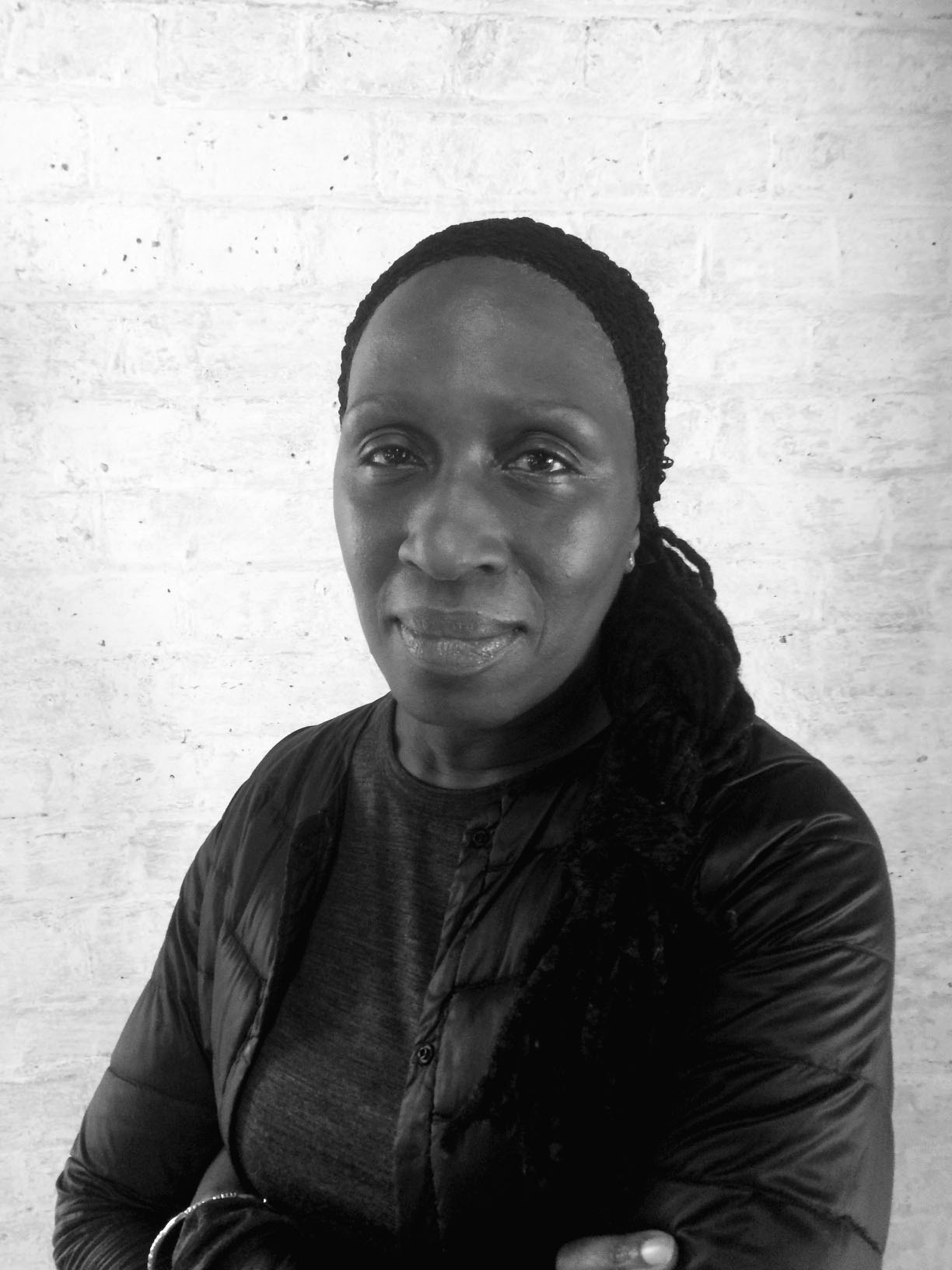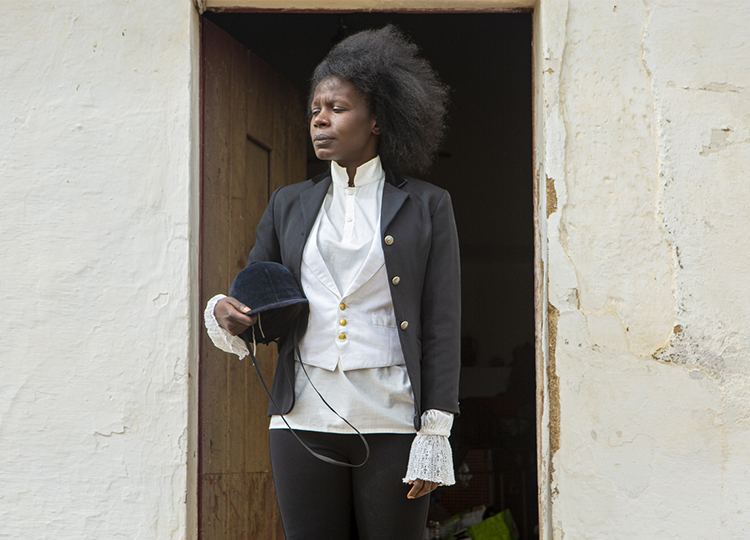For Autograph’s commissioning project Amplify — Stranger in the Village: Afro European Matters, artist Jeannette Ehlers created a new series of photographs using hair as a poetic metaphor to explore the relationship between culture and nature, body and landscape, history and the present; a simple but important marker of identity across communities of African descent.
Here, curator and researcher Karen Alexander considers Ehlers’s dynamic act of recovery and repair in response to the collective legacies of colonialism.
Jeannette Ehlers’s We’re magic. We’re real # 3 (From Sunset to Sunrise), commissioned by Autograph, is a poetic study of sisterhood. In her series of 11 lens-based tableaux, the Danish-Caribbean artist depicts five ‘performers’ in a Danish forest located an hour outside Copenhagen co-joined to each other by long hair braids, signifying both strength and spirituality. Their presence and authoritative demeanour invoke a serene sense of self-knowledge about their past, present and future.
In one image, these ‘priestesses of the forest’ face different directions away from the camera’s gaze in almost a pyramid formation. After absorbing the still beauty of the grouping, we notice the women’s similarities and differences. The five women include Ehlers herself and four other females drawn from her network of Copenhagen-based black female actors and art workers. Choreographed formations and gestures suggest a coded dialogue with their forestry setting. They have varying degrees of skin pigmentation, indicating the African origins of their diasporic gene pool. What unifies the group is the colour of their clothes and the elegant simplicity of their hair. All wear loose-fitting white outfits and sport the same hairstyle: two equal cornrows swept back from the temple, becoming two long plaits that fall across their body. The braids appear to link with those of the adjacent figure like lightning rods of connectivity with no beginning or end. Another image depicts them standing up straight with their backs to the camera, peppered among tree trunks; both braids are trailing down their backs to the ground, where we see the roots of the trees seemingly coming up to meet them. The women represent a root system of solidarity focused on each other and the surrounding forest. Their bodies become valued carriers of wisdom, knowledge, secrets and possibilities undefined by time and place.
In a powerful 2016 Black Entertainment Television awards speech on race and police brutality¹ actor Jessie Williams ends this speech with the words "just because we're magic, does not mean we're not real". The words resonated so deeply with Ehlers they made her cry, and at the same inspired her ongoing series We’re magic. We’re real – a visual affirmation of black female presence and agency.² In this third part of the series, the setting is hard to place geographically or historically, reinforcing a sense of fantasy and mystery. The female group is set against a canopy of trees. The wooded surroundings and the changing light in the images emphasise dreamlike rituals captured by photography. Where are we, who are they, and where did they come from? In some of the pictures the women appear in communion in a semi-trance-like state, at peace with one another and with the location. In two of the images the configuration of the women in and against mature tree trunks recalls intergenerational scenes of women coming together in Daughters of the Dust (1991).³

"memory and the central repositioning of the black female body and the colonial experience are vital features of Ehlers’s work. She creates ‘lost memories’ connected with both personal and national histories"

When writing about the impact of Julie Dash’s landmark feature on the Black Independent Cinema Movement, author Toni Cade Bambara identifies four intertwined themes in the multi-layered text: ‘women’ perspective, women’s validation of women, a shared space rather than dominated space and glamour/attention to female iconography’.⁴ Dash’s film explored the complex coded family histories of communities based in the Sea Islands off the Georgia and South Carolina coast on the eve of their migration north. The multi-award-winning film was critically praised for the excavation of forgotten national memories, the power of the visual storytelling and Dash’s commitment to reimagine and recast African-American female histories. Like Dash, memory and the central repositioning of the black female body and the colonial experience are vital features of Ehlers’s work. She creates ‘lost memories’ connected with both personal and national histories relating to Danish and other European involvement in and the collective legacies of the slave trade. Her work investigates histories that have been selectively forgotten or erased and restores or retrieves them in dynamic acts of recovery and repair.
This reworking of history is a consistent element in Ehlers’s early-career experimental film work, such as Double Me (2003), which manipulates footage from home movies to create a double self-portrait across time. Or Black Magic at the White House (2009), set in Marienborg, the official residence of the Danish prime minister, in which the spirit of a female servant is evoked. Her silhouette elliptically flashes across the fabric and decor of the mansion, performing a Haitian Voudoun dance responding to the intense drumming of the soundtrack. In a recent collaboration with the St Croix based multidisciplinary artist La Vaughan Belle, Ehlers and Belle produced a monumental public statue to commemorate Mary Thomas, a plantation worker – and one of the Queens of the Fireburn – known for leading the 1878 St Croix Fireburn labour riot, one of Denmark’s first and largest labour revolts where workers rebelled against the slave-like conditions that persisted 30 years after slavery was abolished. The allegorical statue named I Am Queen Mary (2018) - the first public statue representing a Black woman in Denmark's history - became a creative and physical union based on 3D scans of each of the artists’ bodies. Ehlers’s practice prioritises the recovery of knowledge via processes of historical critique, affirmation and celebration of her African diasporic identity.
In a groundbreaking text on the cultural politics of black hairstyles, Kobena Mercer observes, ‘Where “race” structures social relations of power, hair – as visible as skin colour, but also the most tangible sign of racial difference – takes on another forcefully symbolic dimension.’⁵ He argues that hair is caught up within the ideological coding of racism in which ‘biological attributes are invested with societal values and meanings’ based on classifications of colour with white at the top and black at the bottom. In her series, Ehlers uses hair, both real and synthetic, in ‘powerful gestures to bring to light and address the history of Denmark’s colonial past in general and its involvement in the transatlantic enslavement in particular. Historically, Western and white-biased cultures and ideologies regarded chemically straightened European hairstyles on black people as ‘positive’, and so-called ‘natural styles’ such as the Afro and dreadlocks as ‘negative’ and ‘politically combative’.

"The braids appear to link with those of the adjacent figure like lightning rods of connectivity with no beginning or end"

Sadly, the stigma and echo of this ideological thinking remain so much so that March 2022 saw the passing of the ‘CROWN Act’⁶ by the US House of Representatives. Ehlers uses hair as a creative raw material to explore underlying narratives about African hair culture and traditions, which state that African hairstyles, particularly cornrows, were employed as survival strategies.⁷ Mercer highlights, ‘Human hair seems to be a natural aspect of the body. Yet hair is never a straightforward biological fact because it is almost always groomed, prepared, cut, concealed, and generally worked upon by human hands. Such practices socialise hair, making it the medium of significant statements about self and society and the codes and values that bind them’.⁸
Ehlers’s series recuperates ideas of beauty associated with black hair and links its presence to the hands-on physical activity of grooming. In so doing, black hair care and styling can be seen as being ‘elevated as a popular art form articulating a variety of aesthetics’,⁹ or, through Ehlers’s eyes, as a celebratory signifier of African diaspora identity and ‘ancestral connectivity’ between women and the earth itself. Each image is a deliberate act of ‘recentring a sense of pride’ as the group engages in collective resistance and rituals of spiritual repair.
Ehlers imbues her images with mythological possibilities that offer multiple readings; the act of looking reveals something more profound. They perhaps represent dreams of a life away from the plantation with the forest symbolising freedom. But as our gaze shifts across the images, their positioning in relation to each other evokes a sense of continued support, steely resolve and steadfastness.
Ehlers’s work contains a deep spirituality linked to its roots in her Afro-Caribbean heritage, fused with a hint of play. Some images recall Henri Matisse’s painting The Dance (1910). Here, five naked figures seem swept up in the rapture of dance against a non-defined background of blue and green. In contrast, Ehlers’s five figures have clothes and are not holding hands, but they are set against an ever-changing blue sky in a green forest. In different ways, both works convey an intense emotional charge. Matisse’s figures are lost in the joy of togetherness and movement, while Ehlers’s ‘priestesses’ communicate through and with their bodies, each displaying an inner serenity in a collective act of meditation and active self-containment. Her images of black people invoke grace and community.
In an essay based on a conference speech, the self-described black lesbian mother warrior poet, Audre Lorde, reflects, ‘My silences had not protected me. Your silence will not protect you. But for every real word spoken for every attempt that I had ever made to speak those truths for which I am still seeking, I had made contact with other women… And it was the concern and the caring of all those women which gave me strength and enabled me to scrutinise the essentials of my living.’¹⁰ Here, Lorde talks about the power of language to transform. Ehlers harnesses the power and intensity of the still image to manipulate the possibilities of being, symbolically calling for urgent conversations focused on historical silences, the need for individual and collective care, and spiritual healing.
______
¹ ‘Read the Full Transcript of Jesse Williams’ Powerful Speech on Race at the BET Awards’ (accessed 18 May 2022).
² When asked about the title for this text Ehlers shared, “I have wanted to use it somehow ever since – and it made sense for this series as it speaks to the immense contributions black people have made to modernity that have been erased from History”. Conversation with the author in April 2022.
³ Daughters of the Dust (1991), directed by Julie Dash, was the first feature-length film written and directed by a black woman to gain a national release in the United States of America.
⁴ Toni Cade Bambara, Deep Sighting and Rescue Missions. Fiction, Essays and Conversations (New York: Pantheon Books, 1996), p. 94.
⁵ Kobena Mercer, ‘Black Hair/Style Politics’, in Welcome to the Jungle (New York: Routledge, 1994), p. 101.
⁶ ‘US House passes bill banning discrimination against Black hairstyles’ (accessed 20 March 2022).
⁷ ‘The Secret Meaning of the African Cornrows’ (accessed 20 March 2022).
⁸ Mercer 1994, p. 101.
⁹ Ibid, p. 100.
¹⁰ Audre Lorde, ‘The Transformation of Silence into Language and Action’, The Audre Lorde Compendium (London: Pandora, 1996), p. 13.

is a London-based independent film and moving image curator and researcher. Alexander has lectured and spoken widely about film, race and representation; her areas of research are UK artists’ film and video, feminist and post-colonial politics of representation and gender.
She has worked with and for the Royal College of Art and the British Film Institute. She has been a guest for a wide range of cultural institutions and art galleries, including Iniva, the Watershed Bristol, Up Projects, Tate, Autograph and the Serpentine Gallery. In 2014, Alexander founded Curating Conversations, a practice-based professional development initiative aimed at emerging visual artists. In 2015, she curated Whip It Good: Spinning From History’s Filthy Mind by Danish/Trinidadian artist Jeannette Ehlers and the Black Atlantic Cinema Club for Autograph, London. She co-founded Philomela's Chorus – a moving image commissioning and exhibition platform for women of colour – in 2017, and organised Dream Time: We All Have Stories for Nuit Blanche Toronto in 2018. Alexander has recently joined the board of Longplayer and is currently a tutor on the Fine Art BA at Central St Martins, University of the Arts, London.

Autograph's commissioning project considering contemporary Afrodiasporic experiences in Europe, supported by the Art Fund.
Read more
Banner image: Jeannette Ehlers, We're Magic. We're Real. #3 (From Sunset to Sunrise). #6 [detail], 2021-22. Commissioned by Autograph for Amplify – Stranger in the Village. Afro European Matters (2021), supported by Art Fund
Images on page: 1-4) Works from Jeannette Ehlers' commission We're Magic. We're Real #3 (From Sunset to Sunrise), 2021-22. © the artist. Commissioned by Autograph for Amplify – Stranger in the Village. Afro European Matters, (2021) Supported by Art Fund. 5) Karen Alexander. 6) Mónica de Miranda, Dressage, from The Island, 2021. Commissioned by Autograph. Supported by Art Fund.
Discover more: 1) Jeannette Ehlers, We're Magic. We're Real. #3 (From Sunset to Sunrise). #9 [detail], 2021-22. Commissioned by Autograph for Amplify – Stranger in the Village. Afro European Matters (2021), supported by Art Fund 2) Whip it Good, performance and gallery installation at Autograph, London. Photos: Zoe Maxwell. 3) Jeannette Ehlers, We're Magic. We're Real. #3 (From Sunset to Sunrise). #6 [detail], 2021-22. Commissioned by Autograph for Amplify – Stranger in the Village. Afro European Matters (2021), supported by Art Fund.
Autograph is a space to see things differently. Since 1988, we have championed photography that explores issues of race, identity, representation, human rights and social justice, sharing how photographs reflect lived experiences and shape our understanding of ourselves and others.